Which One Of The Following Filter Options Is Not Found On The Number Filter Submenu?
Use AutoFilter or congenital-in comparison operators like "greater than" and "top 10" in Excel to show the information you want and hide the residuum. Once y'all filter information in a range of cells or table, you tin either reapply a filter to get up-to-date results, or clear a filter to redisplay all of the data.
Utilize filters to temporarily hide some of the information in a table, so you can focus on the data yous want to see.

Filter a range of data
-
Select any cell within the range.
-
Select Data > Filter.
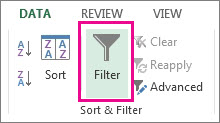
-
Select the cavalcade header arrow
 .
. -
Select Text Filters or Number Filters, and so select a comparison, similar Between.

-
Enter the filter criteria and select OK.
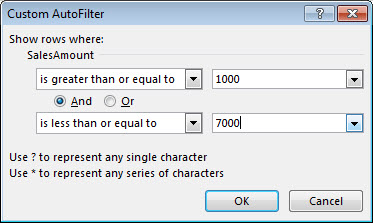
Filter information in a table
When you put your data in a table, filter controls are automatically added to the table headers.
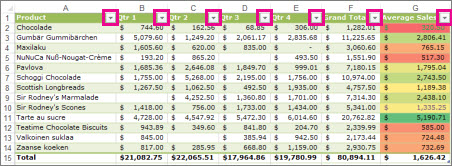
-
Select the column header arrow
 for the cavalcade you want to filter.
for the cavalcade you want to filter. -
Uncheck(Select All) and select the boxes you want to bear witness.
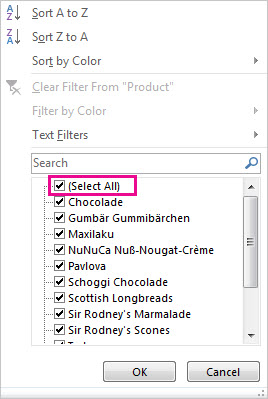
-
ClickOK.
The column header pointer
 changes to a
changes to a  Filter icon. Select this icon to alter or clear the filter.
Filter icon. Select this icon to alter or clear the filter.
Related Topics
Excel Training: Filter information in a tabular array
Guidelines and examples for sorting and filtering data by color
Filter information in a PivotTable
Filter by using advanced criteria
Remove a filter
Filtered data displays just the rows that see criteria that you specify and hides rows that you do not want displayed. After you lot filter data, y'all tin re-create, observe, edit, format, chart, and print the subset of filtered data without rearranging or moving it.
Y'all tin can also filter by more than one column. Filters are condiment, which means that each additional filter is based on the current filter and further reduces the subset of information.
Notation:When yous employ the Detect dialog box to search filtered information, only the data that is displayed is searched; information that is non displayed is not searched. To search all the data, articulate all filters.
The 2 types of filters
Using AutoFilter, you can create two types of filters: past a listing value or by criteria. Each of these filter types is mutually exclusive for each range of cells or column table. For example, you tin can filter by a list of numbers, or a criteria, but non past both; yous can filter past icon or by a custom filter, but non by both.
Reapplying a filter
To decide if a filter is applied, note the icon in the column heading:
-
A driblet-down arrow
 ways that filtering is enabled simply not applied.
ways that filtering is enabled simply not applied.When y'all hover over the heading of a column with filtering enabled merely non applied, a screen tip displays "(Showing All)".
-
A Filter button
 ways that a filter is applied.
ways that a filter is applied.When yous hover over the heading of a filtered column, a screen tip displays the filter applied to that column, such as "Equals a red cell color" or "Larger than 150".
When you reapply a filter, different results appear for the post-obit reasons:
-
Data has been added, modified, or deleted to the range of cells or tabular array column.
-
Values returned past a formula have changed and the worksheet has been recalculated.
Practise not mix data types
For best results, exercise non mix data types, such as text and number, or number and engagement in the aforementioned column, considering only one type of filter control is available for each column. If at that place is a mix of data types, the command that is displayed is the data type that occurs the nigh. For example, if the column contains three values stored equally number and four as text, the Text Filters command is displayed .
Filter information in a table
When you put your data in a tabular array, filtering controls are added to the table headers automatically.
-
Select the data yous want to filter. On the Dwelling house tab, click Format as Table, and and then pick Format every bit Table.
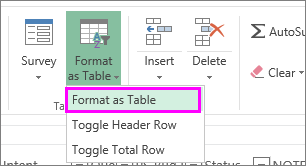
-
In the Create Table dialog box, you tin cull whether your tabular array has headers.
-
Select My table has headers to turn the top row of your data into table headers. The information in this row won't be filtered.
-
Don't select the check box if you desire Excel for the web to add placeholder headers (that you can rename) higher up your table data.
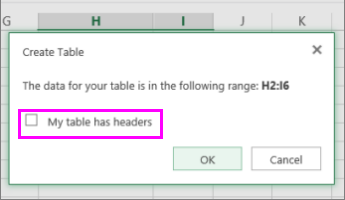
-
-
Click OK .
-
To use a filter, click the pointer in the cavalcade header, and option a filter option.
Filter a range of data
If you don't want to format your data as a table, you can likewise apply filters to a range of information.
-
Select the information you desire to filter. For best results, the columns should take headings.
-
On the Data tab, cull Filter.
Filtering options for tables or ranges
You tin either apply a full general Filter option or a custom filter specific to the data type. For example, when filtering numbers, you'll see Number Filters, for dates you'll see Date Filters, and for text you'll see Text Filters. The general filter option lets you lot select the data yous want to meet from a list of existing data similar this:
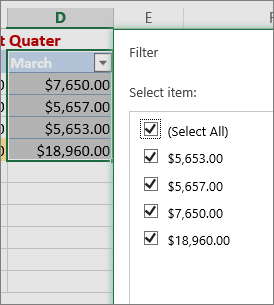
Number Filters lets you apply a custom filter:
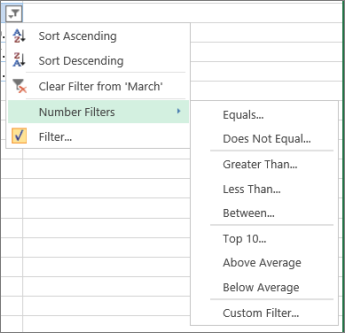
In this example, if you want to run into the regions that had sales below $half dozen,000 in March, you lot tin can apply a custom filter:

Here'south how:
-
Click the filter arrow next to March > Number Filters > Less Than and enter 6000.
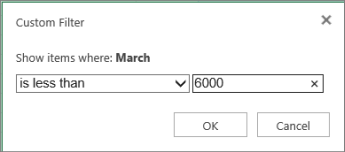
-
Click OK.
Excel for the web applies the filter and shows merely the regions with sales below $6000.

You tin can use custom Date Filters and Text Filters in a similar manner.
To articulate a filter from a column
-
Click the Filter
 button side by side to the cavalcade heading, and and then click Clear Filter from <"Column Proper name">.
button side by side to the cavalcade heading, and and then click Clear Filter from <"Column Proper name">.
To remove all the filters from a table or range
-
Select any cell inside your table or range and, on the Data tab, click the Filter button.
This will remove the filters from all the columns in your table or range and show all your information.
-
Click a jail cell in the range or tabular array that you desire to filter.
-
On the Data tab, click Filter.

-
Click the arrow
 in the cavalcade that contains the content that you want to filter.
in the cavalcade that contains the content that you want to filter. -
Under Filter, click Choose 1, then enter your filter criteria.
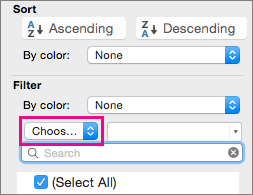
Notes:
-
You tin can apply filters to but one range of cells on a sheet at a time.
-
When y'all use a filter to a column, the only filters bachelor for other columns are the values visible in the currently filtered range.
-
But the first x,000 unique entries in a listing announced in the filter window.
-
Click a cell in the range or table that you desire to filter.
-
On the Data tab, click Filter.

-
Click the arrow
 in the cavalcade that contains the content that you lot want to filter.
in the cavalcade that contains the content that you lot want to filter. -
Under Filter, click Cull I, and and so enter your filter criteria.

-
In the box side by side to the pop-up carte, enter the number that you lot desire to employ.
-
Depending on your choice, y'all may exist offered additional criteria to select:
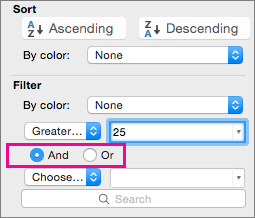
Notes:
-
Y'all can employ filters to just i range of cells on a sail at a time.
-
When you apply a filter to a column, the only filters available for other columns are the values visible in the currently filtered range.
-
Only the first 10,000 unique entries in a list announced in the filter window.
-
Instead of filtering, y'all tin can use conditional formatting to brand the superlative or bottom numbers stand out clearly in your data.
Yous tin speedily filter data based on visual criteria, such as font color, cell color, or icon sets. And yous tin filter whether you accept formatted cells, applied prison cell styles, or used conditional formatting.
-
In a range of cells or a tabular array column, click a cell that contains the cell color, font color, or icon that you desire to filter by.
-
On the Data tab, click Filter .

-
Click the arrow
 in the column that contains the content that yous want to filter.
in the column that contains the content that yous want to filter. -
Under Filter, in the By color pop-upwardly card, select Cell Color, Font Color, or Cell Icon, and then click a colour.
This option is available only if the column that you desire to filter contains a bare cell.
-
Click a cell in the range or table that you want to filter.
-
On the Data toolbar, click Filter.

-
Click the arrow
 in the cavalcade that contains the content that you lot want to filter.
in the cavalcade that contains the content that you lot want to filter. -
In the (Select All) area, gyre downward and select the (Blanks) check box.
Notes:
-
You tin apply filters to merely one range of cells on a sheet at a fourth dimension.
-
When you apply a filter to a column, the only filters bachelor for other columns are the values visible in the currently filtered range.
-
Just the commencement 10,000 unique entries in a listing appear in the filter window.
-
-
Click a cell in the range or tabular array that yous want to filter.
-
On the Data tab, click Filter .

-
Click the arrow
 in the cavalcade that contains the content that you want to filter.
in the cavalcade that contains the content that you want to filter. -
Nether Filter, click Choose Ane, then in the pop-upwards carte, do one of the following:
To filter the range for
Click
Rows that contain specific text
Contains or Equals.
Rows that practice non incorporate specific text
Does Not Contain or Does Not Equal.
-
In the box next to the popular-upward menu, enter the text that you desire to apply.
-
Depending on your choice, you may exist offered additional criteria to select:

To
Click
Filter the tabular array column or selection so that both criteria must be truthful
And.
Filter the table column or choice so that either or both criteria can exist true
Or.
-
Click a jail cell in the range or tabular array that you desire to filter.
-
On the Data toolbar, click Filter .

-
Click the arrow
 in the column that contains the content that you want to filter.
in the column that contains the content that you want to filter. -
Under Filter, click Choose 1, and then in the pop-upwards menu, practise one of the post-obit:
To filter for
Click
The beginning of a line of text
Begins With.
The terminate of a line of text
Ends With.
Cells that contain text but practise not brainstorm with letters
Does Not Brainstorm With.
Cells that contain text only do not stop with letters
Does Not End With.
-
In the box adjacent to the pop-upwardly menu, enter the text that yous want to apply.
-
Depending on your choice, y'all may be offered additional criteria to select:

To
Click
Filter the table cavalcade or selection so that both criteria must be truthful
And.
Filter the tabular array column or option so that either or both criteria can exist true
Or.
Wildcard characters tin be used to help y'all build criteria.
-
Click a cell in the range or table that y'all desire to filter.
-
On the Information toolbar, click Filter.

-
Click the pointer
 in the column that contains the content that you want to filter.
in the column that contains the content that you want to filter. -
Under Filter, click Cull I, and select any option.
-
In the text box, type your criteria and include a wildcard character.
For example, if yous wanted your filter to catch both the word "seat" and "seam", type body of water?.
-
Do one of the post-obit:
Use
To find
? (question mark)
Whatever single character
For case, sm?th finds "smith" and "smyth"
* (asterisk)
Any number of characters
For example, *eastward finds "Northeast" and "Southeast"
~ (tilde)
A question mark or an asterisk
For example, there~? finds "there?"
Do any of the following:
| To | Practice this |
|---|---|
| Remove specific filter criteria for a filter | Click the arrow |
| Remove all filters that are applied to a range or tabular array | Select the columns of the range or tabular array that have filters practical, and then on the Information tab, click Filter. |
| Remove filter arrows from or reapply filter arrows to a range or table | Select the columns of the range or tabular array that have filters applied, and then on the Data tab, click Filter. |
When y'all filter data, merely the data that meets your criteria appears. The information that doesn't meet that criteria is hidden. After y'all filter information, you tin copy, discover, edit, format, nautical chart, and print the subset of filtered data.
Table with Height 4 Items filter applied

Filters are condiment. This means that each boosted filter is based on the current filter and further reduces the subset of data. You can make complex filters by filtering on more than one value, more than than one format, or more than one criteria. For example, you lot tin filter on all numbers greater than 5 that are besides below average. Only some filters (top and bottom ten, higher up and below average) are based on the original range of cells. For example, when yous filter the top ten values, y'all'll come across the top ten values of the whole list, not the height ten values of the subset of the last filter.
In Excel, yous can create iii kinds of filters: by values, by a format, or by criteria. But each of these filter types is mutually exclusive. For example, you lot can filter past cell color or by a list of numbers, but not past both. You can filter by icon or past a custom filter, but not by both.
Filters hide extraneous data. In this manner, you lot can concentrate on just what you want to see. In dissimilarity, when yous sort data, the data is rearranged into some social club. For more information nearly sorting, run across Sort a list of data.
When y'all filter, consider the post-obit guidelines:
-
But the first 10,000 unique entries in a list appear in the filter window.
-
You can filter by more than one cavalcade. When yous employ a filter to a column, the only filters available for other columns are the values visible in the currently filtered range.
-
You can apply filters to merely i range of cells on a sheet at a time.
Note:When yous use Find to search filtered information, merely the data that is displayed is searched; information that is not displayed is not searched. To search all the data, clear all filters.
Need more help?
You tin always ask an expert in the Excel Tech Community or get support in the Answers community.
Which One Of The Following Filter Options Is Not Found On The Number Filter Submenu?,
Source: https://support.microsoft.com/en-us/office/filter-data-in-a-range-or-table-01832226-31b5-4568-8806-38c37dcc180e
Posted by: schmidttheran.blogspot.com


0 Response to "Which One Of The Following Filter Options Is Not Found On The Number Filter Submenu?"
Post a Comment